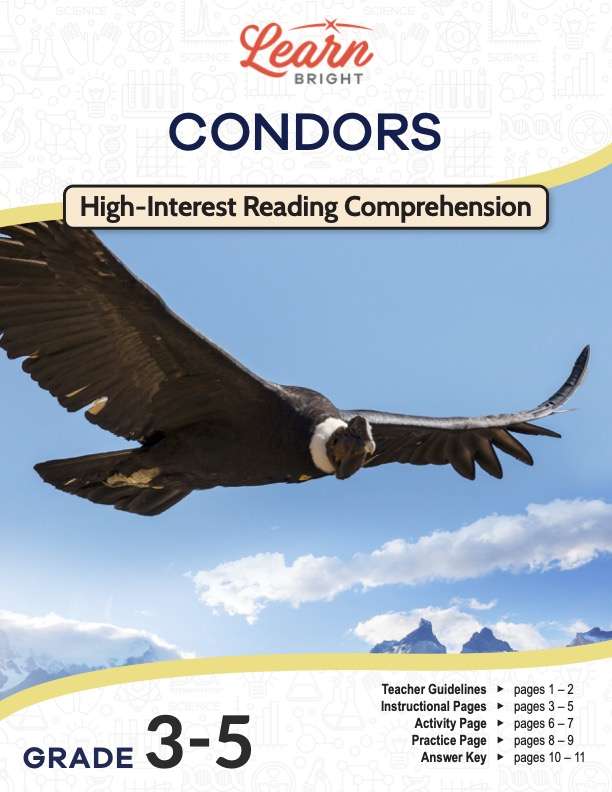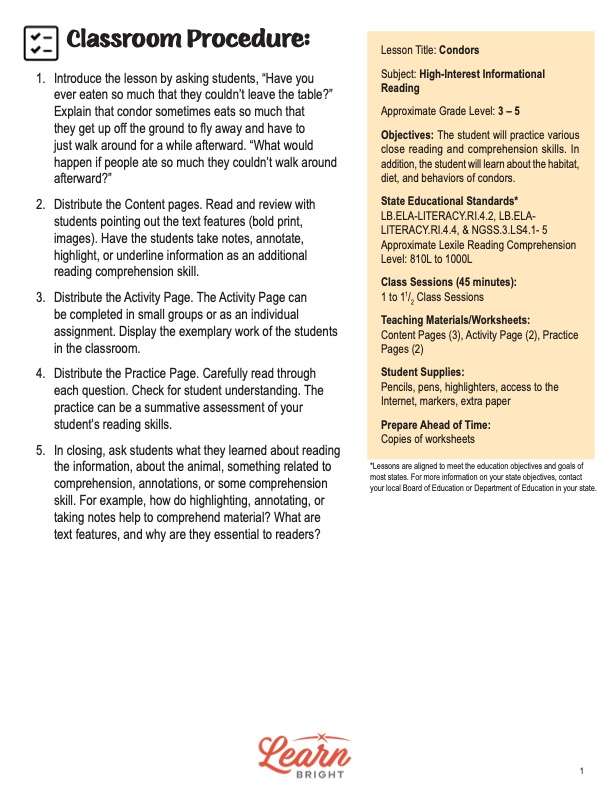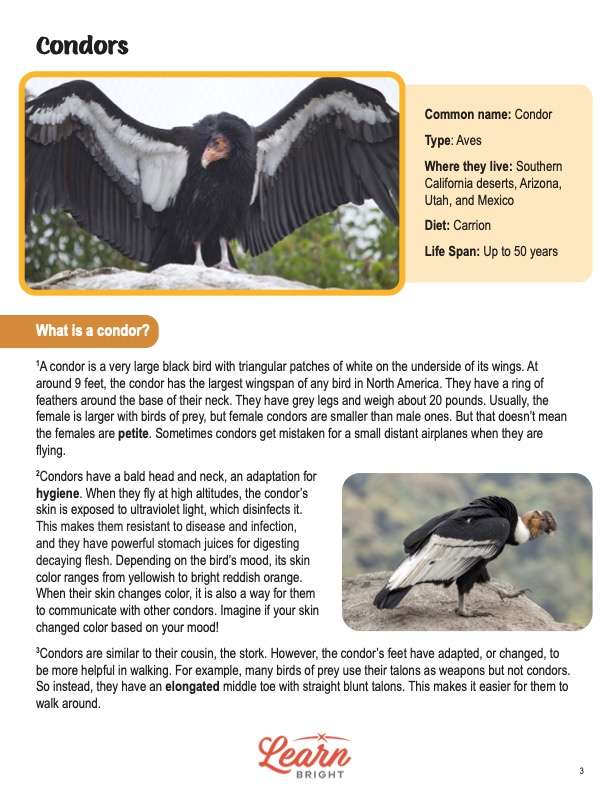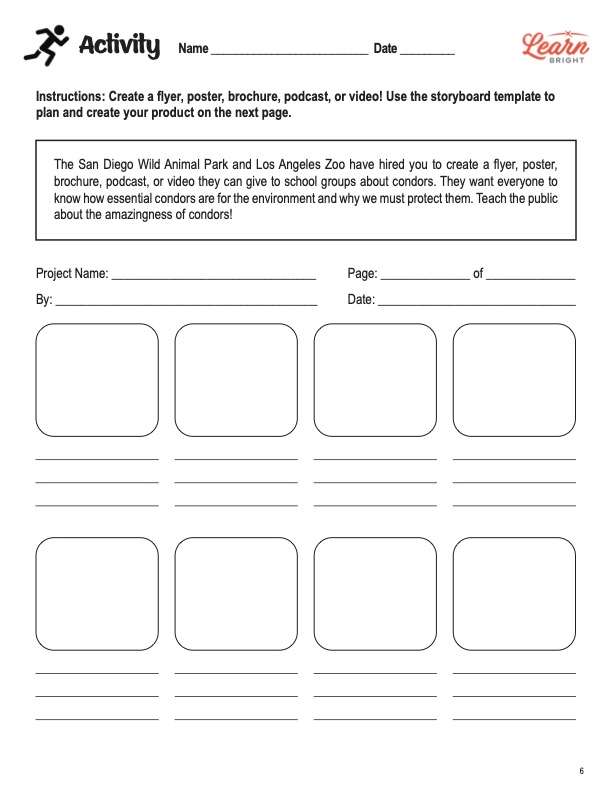Description
What our Condors lesson plan includes
Lesson Objectives and Overview: Condors is a high-interest reading comprehension lesson plan. As such, students will practice various close reading and comprehension skills. In addition, they will learn about the habitat, diet, and behaviors of a condor. This lesson is for students in 3rd grade, 4th grade, and 5th grade.
Classroom Procedure
Every lesson plan provides you with a classroom procedure page that outlines a step-by-step guide to follow. You do not have to follow the guide exactly. The guide helps you organize the lesson and details when to hand out worksheets. It also lists information in the yellow box that you might find useful. You will find the lesson objectives, state standards, and number of class sessions the lesson should take to complete in this area. In addition, it describes the supplies you will need as well as what and how you need to prepare beforehand.
Teacher Notes
The teacher notes page provides an extra paragraph of information to help guide the lesson. It explains that you can teach this lesson in a whole-class setting or to an independent, small group as an activity. You can use the blank lines to write down any other ideas or thoughts you have about the topic as you prepare.
CONDORS LESSON PLAN CONTENT PAGES
What Are Condors?
The Condors lesson plan contains three content pages. It begins by providing a box of background information about this animal. Condors are a bird, or part of the aves class. They live in Southern California deserts, Arizona, Utah, and Mexico. Their diet includes carrion, which is the decaying flesh of dead animals. This bird can live for up to 50 years.
A condor is a very large black bird with triangular patches of white on the underside of its wings. At around nine feet, the condor has the largest wingspan of any bird in North America. They have a ring of feathers around the base of their neck and grey legs, and they weigh about 20 pounds. Usually, the female is larger with birds of prey, but female condors are smaller than male ones. That doesn’t mean the females are petite. Sometimes people mistake condors in flight for small, distant airplanes.
These unique birds have a bald head and neck, an adaptation for hygiene. When they fly at high altitudes, the condor’s skin is exposed to ultraviolet light, which disinfects it. This makes them resistant to disease and infection, and they have powerful stomach juices for digesting decaying flesh. Depending on the bird’s mood, its skin color ranges from yellowish to bright reddish orange. When their skin changes color, it is also a way for them to communicate with other condors. Imagine if your skin changed color based on your mood!
Condors are similar to their cousin, the stork. However, their feet have adapted (changed) to be more helpful in walking. For example, many birds of prey use their talons as weapons, but not condors. Instead, they have an elongated middle toe with straight, blunt talons. This makes it easier for them to walk around.
Condor Diet
The next section discusses diet. Wild condors can travel up to 150 miles a day for food. As a result, they have vast territories in which to find food. They eat carrion, which is the decaying carcass of a dead animal. Condors prefer to feast on mammals like deer, sheep, goats, donkeys, horses, pigs, mountain lions, bears, or cows. But they will also eat the bodies of smaller animals like rabbits, coyotes, and even reptiles.
You might think that what condors eat would smell really terrible. But lucky for them, they don’t have a sense of smell. Instead, condors have sharp eyesight, so they soar high above on wind thermals, looking for dead things. They also find carrion by looking for other scavengers who cannot rip through the tough hides of larger animals.
These large birds use their sharp, hooked beaks and powerful jaws to yank, pull, and tear meat from a carcass. They will also intimidate other scavengers into leaving a carcass, except for bears and golden eagles. Bears don’t care if a condor is around and will ignore them. And the golden eagle will stand its ground and fight.
Condors need vast areas of undeveloped land to find food. In the wild, they are intermittent eaters. They will go somewhere between two days and two weeks without eating and then gorge themselves on meat all at once. In fact, sometimes condors eat so much that they can’t lift themselves off the ground to fly away!
Other Interesting Facts
The second half of this page offers some fun facts. Condors are very particular about cleaning themselves, especially after a meal. They preen, which means they straighten and clean their feathers with their beak. And they also use pond water to clean and dry themselves for hours. If there is no water around, they use rocks and plants as napkins to help clean their bodies.
In addition, these birds are very social animals and like being around other condors. In fact, they can form strong bonds with each other, just as you form strong bonds with your friends. And they are very playful and curious. Condors love to play fight, preen each other, or get together and inspect new things they find in the area.
When it gets hot outside, these birds don’t sweat as we do to release heat. Instead, they poop on their legs! While this may sound disgusting to you, it is an effective way for them to reduce their body temperature. The scientific name for this process is urohidrosis.
Why Condors Are Important
Condors are like the clean-up crew of the wild. They are great for the environment because they eat animal carcasses that could transmit diseases to humans, wildlife, and livestock. That means that when they eat the carcasses, they help prevent disease outbreaks. We can stay healthy because condors do the dirty work. The birds are also sensitive to certain toxins and pollutants, so they bring attention to areas that may be ecologically unhealthy.
Students will discover that condor populations have decreased because of lead poisoning, poaching, and habitat destruction. In 1987, the population had gotten so low that the US government captured all the wild condors and put them in captivity to help their numbers grow again. Recently, there are now enough condors that we can release some of them back into the wild.
CONDORS LESSON PLAN WORKSHEETS
The Condors lesson plan includes two worksheets: an activity worksheet and a practice worksheet. Each one will help students solidify their grasp of the material they learned throughout the lesson. You can refer to the classroom procedure guidelines to know when to hand out each worksheet.
PROTECT THE CONDORS ACTIVITY WORKSHEET
For the activity, students will create a product that promotes the protection of condors. They can create a flyer, poster, brochure, podcast, or video. The page provides a storyboard template to assist students in their planning. It also offers a prompt that help guide the project. Students can use the second activity page to outline and draft their product.
CONTENT REVIEW PRACTICE WORKSHEET
The practice worksheet requires students to answer a series of 11 questions. These questions all relate to the content pages, so students will need to refer to them often for the answers. In addition, each question provides which reading tool the question corresponds to, such as text feature, vocabulary, or comprehension.
Worksheet Answer Keys
At the end of the lesson plan document is an answer key for the practice worksheet. The correct answers are all in red to make it easier for you to compare them with students’ responses. If you choose to administer the lesson pages to your students via PDF, you will need to save a new file that omits these pages. Otherwise, you can simply print out the applicable pages and keep these as reference for yourself when grading assignments.










